My memories of Imphal from 1941
- Part 19 -
Dr Mohendra Irengbam *
![Author on a salvaged WWII motorbike with Kh Dhiren from Kongba [introduced high-yielding varieties of rice], after haircut by barber's saloons at Makha Dukan in 1955, during our summer holidays from college.](http://www.e-pao.org/galleries/images/misc/2021/03/Mohendra_20210307_1.jpg)
Author on a salvaged WWII motorbike with Kh Dhiren from Kongba [introduced high-yielding varieties of rice], after haircut by barber's saloons at Makha Dukan in 1955, during our summer holidays from college.
It is not such a terminally stupid notion that the differentiation between peoples, depends on the effects of education and discipline. People of my age, can see vast changes in Meitei national character over the past 70 years as a result of increasing literacy. Education is a legitimate source of status difference and with it comes a disciplined behaviour. Not everyone though, has an equal opportunity of getting to university. Status inequalities have always existed. And so, I oscillate widely between feeling saturnine and broken in mirth.
By the early 1960s, the belligerent and narcissistic culture of Meitei youth that I wrote in my essay on the Meitei National Character, was morphing into a more gregarious comportment than philistine. This accrued from the spread of postwar education. More educated youth came out from colleges in Imphal and outside. They also became more disciplined. In retrospect, this strikes a chord with a recent research finding about racism in the UK.
Dr Robert Ford published the findings of the British Social Attitudes Survey in 2013. "The generational decline in racial prejudices is also not evenly spread. Generational shifts in attitudes have been most rapid among highly educated Britons, those in high status occupations and among women. Younger generations of these groups seem to have been completely socialized into a tolerant set of 'multicultural' norms, and rarely express any discomfort about social contact with ethnic minorities."
The consequences of Japan Lan between the periods from 1945-1950, set off a trend in cultural transformation, which completely changed the outlook of Meiteis. The role the War played by chanceis bigger than the young generations would realise. The social, political and intellectual developments were inevitably inflected by changes wrought about by the effects of WWII. The conflicting pulls of passivity and active commitment have often determined the mood of the educated youth.
Less viscerally, one could make out the lineaments of modern English education on the comportment of many students who studied at colleges outside Manipur. Illiterate Manipuri parents began to grasp the value of English education of their children. They began to notice the gap between Lairik heiba (educated) and Lairik heitaba (uneducated). That is, a lay person could notice the difference between educated and uneducated youngsters.
An educated person is open-minded while the uneducated is self-centred. Because of the interaction between different cultures during the War, and the emergence of more educated people in the postwar period, a kind of new thought about education began to emerge. Thus began the period of renaissance or rebirth of Manipuri Literature as written works of prose and poetry of artistic and superior merits began to appear, though there are obvious problems with trying to determine what was going on in their heads
Works on Manipuri literature can be said to have existed for a long period in Meitei history. However, all interpretation is situational, constrained by the relative criteria of a particular culture at that time. Modern Manipuri literature began to surface in the early part of the 20th century. Thanks to a gallery of liberal young Meitei men with a yearning for modernism, to engage in knowledge advances. They were those who had higher education outside Manipur, such as Shillong, Gauhati, Sylhet, Dacca and Calcutta.
There are theories of what literature is. The one I like is what a Russian critic Roman Jakobson wrote: "Literature represents an organised violence committed on ordinary speech." Literature transforms and intensifies ordinary language and deviates systematically from everyday speech. Literature is a special kind of language that contrasts to the common language we use. Some literature is fictional and some is not.
During the time of minor Raja Churachand Singh, the British Political Agent administered the state on his behalf until the administration was handed over to him on May 15 1907. This period was called 'under British management', during which, the government parwana (urdu = notifications) were issued in Manipuri. That was the real beginning of refined Manipuri language.
Attempts began in the 1920s to get Manipuri recognised as a vernacular for the Prabeshika (Bengali = matriculation) for Calcutta University, by a few educated Meiteis. These pioneers put their shoulders to the wheel and after years of twiddling their thumbs, Manipuri was recognised as a vernacular subject by Calcutta University in 1924. When I was studying in class V at Johnstone High School, a few teachers like Khwaikrakpam Chaoba and others used to tell us what they had to do for it.
The first experience of Meitei literate civilisation came to Manipur in about 770 CE with Poireiton Khunthok (the early settlement account of Poireiton), followed by Nummti Kappaa (preHindu mythologies), Ningthouron Lambuba (military prowess of Meitei kings), Leithak Leikharon (an account of the Meitei concept of the creation with gods and goddesses).
Cheitharol Kumbaba (short chronicles of the activities and times of Meitei kings) dates back to second century CE, beginning with Nongda Lairen Pakhangba. Another book, Chakpa Khunda Khunthok tells the subjugation of smaller Kangba clan, which was absorbed by the Pakhangba clan. What can really be called refined prose literature, was the publication of Nungbaan Poimbi Luwaoba in the 16th century. It is a narrative of the intense love of Luwaoba for his wife Koubaron that forced the gods to restore her life.
Newer forms of Manipuri literature began after the Hinduisation of Meiteis into a sect of Hinduism, called Gaurya Vaishnavism (Bengali Vaishnavism). It was started by a Brahmin Chaitanya (alias Gouranga) as Bhakti movement at Navadeep, a district of Bengal. It flourished during the reign of Gharib Nawaz (alias Pamheiba, 1690-1751 CE). Kangleipak changed to Manipur in 1724. It began with the translation of Mahabharata and Ramayana from Bengali.
In the pre and postwar periods, there were quite a few religious books translated from Bengali or Sanskrit, such as abridged Ramayana by Gokul Shastri (1890); abridged Mahabharata by Gokul Shastri (1900); Bhagavad Purana by Phurailtpam Atombapu Sharma; Bhagad Gita by Kalachand Shastri, Meghanandvadh from Michael Madhusudan's Bengali poems by H Nabadwip Singh,
Shreegeeta by Khumanthem Gourakishore; and Shrimadbhagabad Gita by Shitaljit. Kalachand Shastri, as well as by Shitaljit. Both were my teachers at Johnstone School.
My father Irengbam Gulamjat (1896-1992) was also involved in writing, mostly translations from Bengali and Sanskrit, such as Radhakrishna Premkali, Shreegobinda Leela Amrita, Shree Geetgovnida and others. His prose poetry translations had his own style of prosody and meter, called Padya Chanda. A combination of lyrical and metric elements of poetry with idiomatic elements of prose. He was the first Manipuri who translated Bhakti sankritan from Bengali to Manipuri, which is now sung in Ras Lila performances
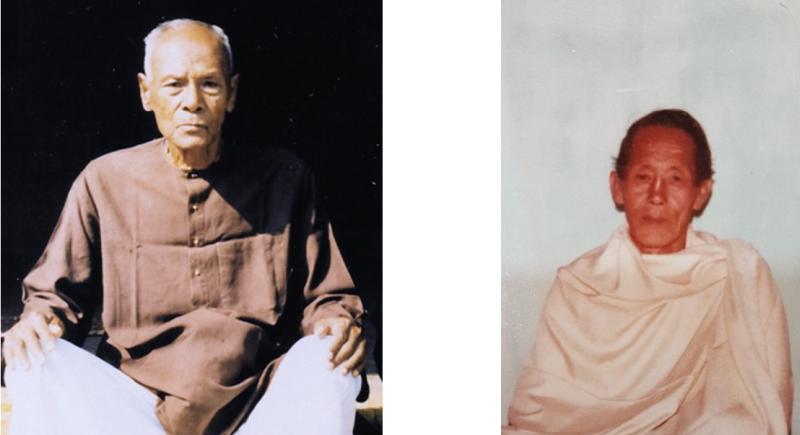
(L) Irengbam Gulamjat Singh (R) Khumanthem Gourakishore Singh
As a prequel and sequel of Japan lan, the only prose literary books we knew in the immediate postwar period, were Dr Kamal's Madhabi (1896-1951), Hijam Angamghal's Khamba Thoibi sheireng (1892-1943) and Hijam Irabot's Sita (1896-1951), and Khwairakpam Chaoba's Labanga-Lata (1896-1950), Hawaibam Nabadwipchandra's poems, Tonulaijinglembi Kavya (1897-1946), and Ashangbam Mineketon's Meitei Upanyas (1906-1995).
These early prose literature consisted of deeply complacent themes on romantic love, fettered by the convention of time, and Meitei national identity, so lovingly adumbrated by Dr Kamal in his Madhabi (1930). He was an innovator of writing novels in Manipuri. In Madhabi, he wrote titillating stories of romantic love and sacrifice. He had the aesthetic ability to transform his words and his own personal style of writing. He transformed Canchipur as a dreamy exotic landscape as in Homer's Odyssey. His poems: Kanchipurgi lemhouba Makhak and Chandranadi resonate with alluring image of Canchipur. I think he is the father of mnedieval Manipuri literature.
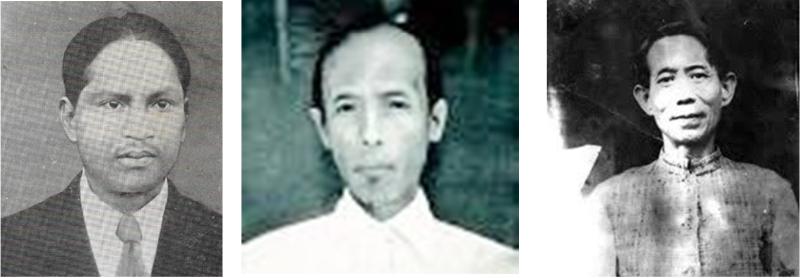
(L) Lamabam Kamal Singh (M) Khwairakpam Chaoba Singh (R) Hijam Irabot Singh
Kamal's contemporary Khwairakpam Chaoba, also wrote sad poetry (elegy), being sorry for himself, such as Chingda satpi engelei and Thainagi Leirang. Chaoba. He was a teacher at Johnstone High School.
He taught us that one should write a poem with one's emotions, not just make it up ie not just to include the emotion but to describe your emotions. He like Charles Dickens, transformed Manipuri literature and gave it a face, single-handedly.
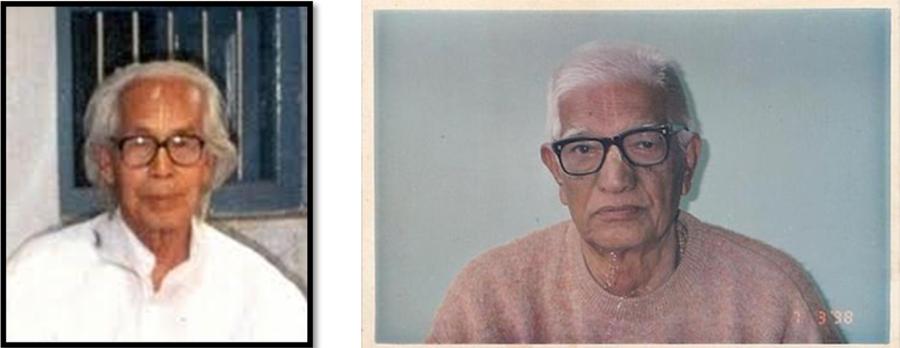
(L) Ashangbam Mineketan Singh (R) RK Shitaljit Singh
Among the modern writers, Ashangbam Mineketan, was one of the rare high-profile scholars of Manipuri literature. He emphasised the utopian root of literature He was also my teacher at Johnstone School. At my time, he was known to have his own poetical style, using a lot of archaic Manipuri words.
He published many books and papers, and was a recipient of many prestigious awards. And I believe he is regarded as the founder of Modern Manipuri literature. I am inclined to agree. He was the earliest professor of Manipuri language and literature at the newly built DM College.
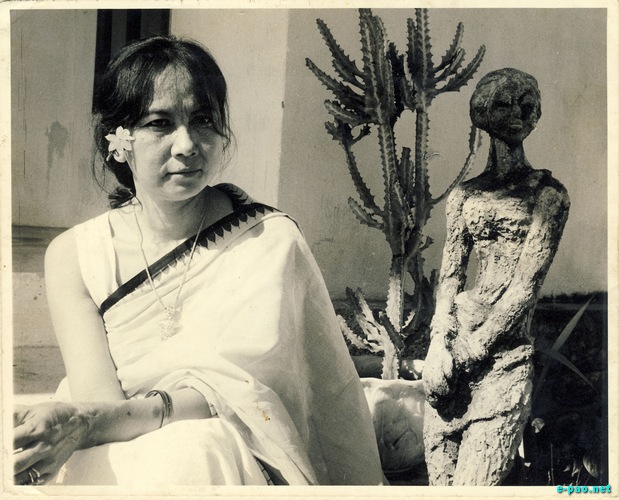
MK Binodini Devi
The most well-known, and beloved modern Manipuri writer, does not need introduction. She is MK Binodini Devi. Her literary device is the use of Manipuri words and phrases that bring in some kind of feeling to the words' usual meaning.
Her writings are always distinguishable by being creative with a comfortable flow of words and with a logical structure of syntax. She was one of the most deliberate and assiduous neologisers of the twentieth century Manipuri.
I met her when she came to our house to see my father to give her condolences on the death of my mother in June 1990. I have read most of her books including a few that she presented to me on July 17 1992, such as ashangba Nongjabee (1967), nungngairakta Chandramukhi (1967) and Churachand Maharaj gi emung (2008). The last one is most enjoyable as it uncovers the unknown stories of history.
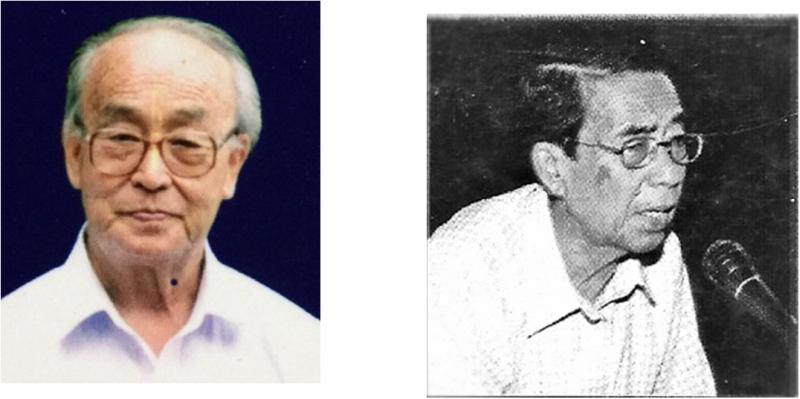
(L) Elangbam Sonamani Singh (R) Leimapokpam Damodar Singh
One author of eminence, who harnessed his dreams and preserved them through writing, is Elangbam Sonamani Singh. He has been decorated with a variety of awards. I knew him since immediate postwar years. His writings in any genre have takeaway values. The plots are always engaging, using a setting to advance the plot. The story always has a satisfying ending. I went to see him in November 2019. I cherish is his debut, ninggaidabi- a prose poetry narrative, consisting of 9 verses (1988). In his short stories, he has a gift for creating atmosphere.
There have been many modern litterateurs in Manipuri. But as I have been living in the UK for over half a century, I have been familiar with only a very few of them. One was my contemporary and friend, Leimapokpam Damodar Singh (ex-Principal of Imphal College). I knew Damodar from school days. He wrote: Manipuri Leela Macha (1975) and Manipuri wari macha (1992).
Damodar gave me two of his books: Dr L Kamal Singh (2000), and Aspects of Manipuri Literature (2008). His literary criticism of the works of many authors in these books, police their potentially unintelligible details, and rescues from the ravages of history for all time.
He persuasively interprets complex texts to help students empathise with their works. Though the question remains how does he, as a critic, claim to have godlike knowledge of the text that is denied to an average reader. Drawing an analogy, it can be asked how one can know the light in the refrigerator is off when the door is closed. It is because he can interpret what is logically constrained in the text itself.
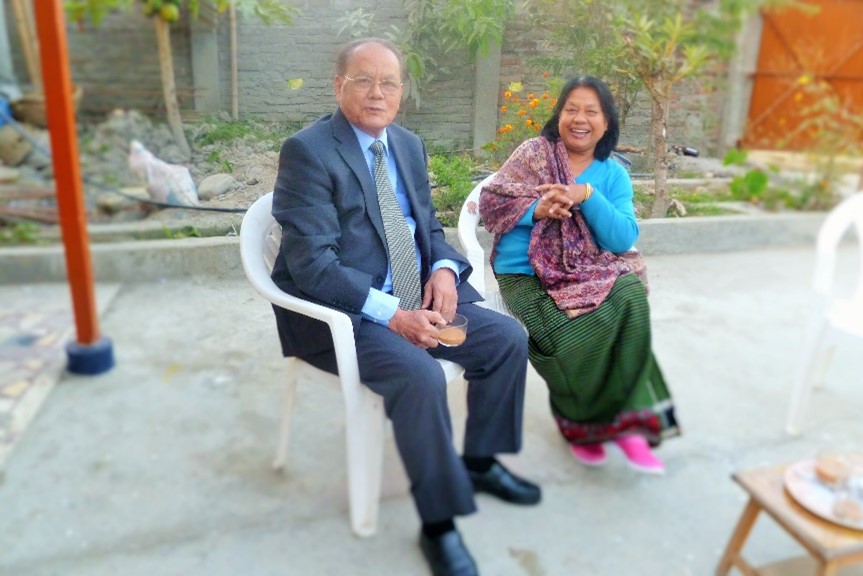
(L-R) Author and Binapani at her home in 2016
Among the modern junior women writers, Thokchom Binapani Devi stands out a mile. I knew her as the youngest daughter of Dr Goberdhan Singh, the first Meitei doctor. I read her books: Lambishina Loishilakpada (2010) and Manigi Mangal (2011).
Manigi Mangal which she gave me in 2013, is delightful with a funny mix of the profound and the mundane, giving the reader an instinctive glimpse into the days of yonder years in Manipur. This quality literature stands the test of time.
Another book Lambisina Loishinlakpada, which she kindly presented to me in 2016, turns out to be her autobiography. It is very riveting until I arrive at that portion where the victim of the perpetual domestic violence from an uncouth husband, turns out to be herself. She blames her marriage as a regrettable quirk of fate that was circumstantially forced upon her by Meitei societal culture. She has many awards in literature and for audio-visual documentaries.
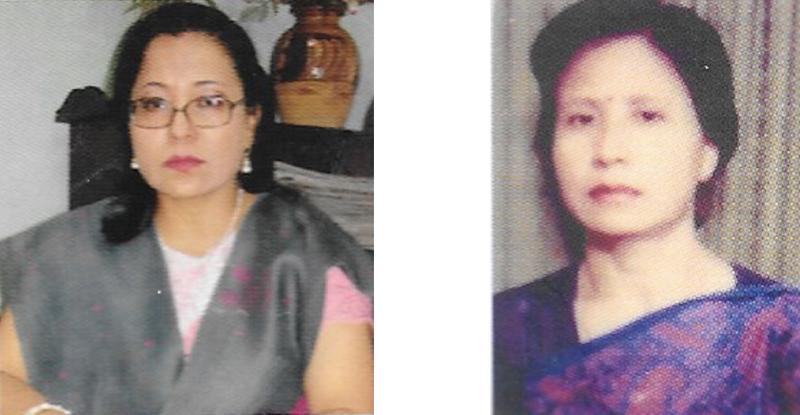
(L-R) Priyadarshan M Gangte ; Arambam meme Devi
A female academic writer is Priyadarshani Maisnam Gangte, MA, Ph. D, LLM, Assoc. prof. of history, Damdei Christian College, Motbung, Manipur. Her research works about the tribal communities of Manipur, especially the Chikim, is inescapable. She has published many papers in top academic journals, and authored many books. She believes in the solidarity of all the communities in Manipur. I find her feminist response as the Editor, in her book: Indian women through the ages, for enhancing the participation of women in all walks of life, as an eye opener for alpha males.
Over the years, I read her articles in the Sangai Express, which were meaningful and intense. She gave me a few of her books in November 2019, which I was reading for pleasure to improve my sense of connectedness to the wider communities in Manipur. To my pleasant surprise, I found her quoting me in her book, Tribal Land, History and Culture and Other Essays (2013, p275). She is a public intellectual. One of the few cerebral writers of Manipur. As a recipient of many high-status awards, she represented India in the World Peace Conference, held in Athens, Greece in 2000.
Among young female poets, I was lucky to meet Arambam Meme Devi in 2017, when she gave me her book of poetry, chillo pamjana, containing 24 poems. Her dedication of the book to her late elder brother Sharat, who was my contemporary and friend, is very stirring.
The dedication is also the title of her book:
Eshei kaya sheireng kaya ibiramba
Ibung Sharat Arambam
Nanggee nafamda nachanna katchari
Chillow pamjana
I was knocked for six by the skill, rhyme, tone and implied meanings of her poems. They are descriptive with good imaginations and clear images. Her literary techniques and conventions make readers think seriously. One of her poems, hangoigee serfala for example, about a drunken husband is extremely joyous. Her poems deal with passion, melancholy, dreams, life, and death. They are singularly original, beautiful and elegiac. Above all, I appreciate the poet in Meme.
Meme reminds me of John Keats, who wrote 'Ode to a Nightingale'. I once, went to see the plumb tree, under which Keats sat and wrote the poem. It grows in a small garden house in North London. I remembered him as I studied English language and literature in the college.
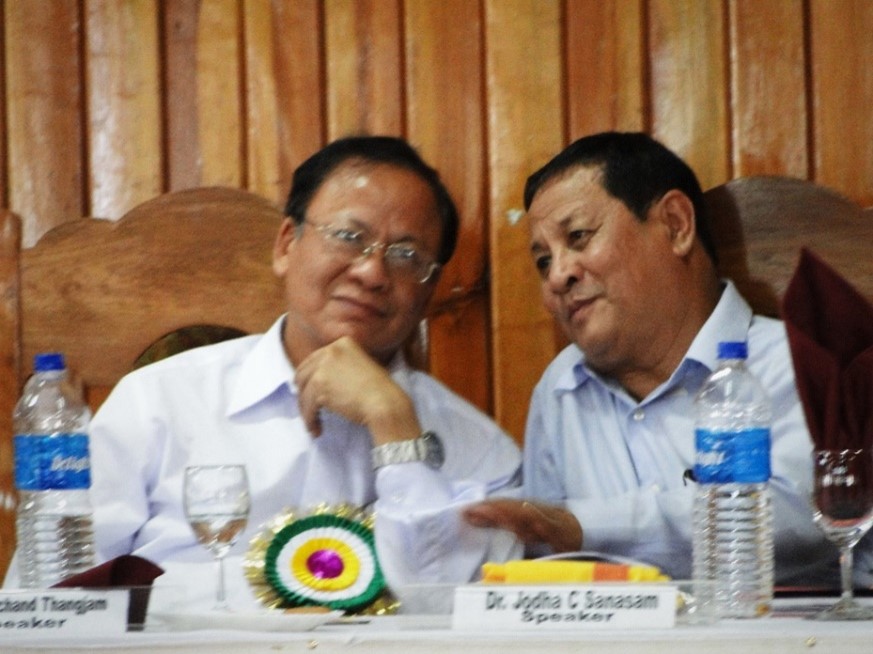
(L-R) Dr Premchand Thangjam ; Dr Jodha Sanasam :: At my Book Launch in 2013, Imphal
Among the prominent young male writers, Dr Sanasam Jodha Singh is commendable. He gave me his novel Akanba Shafugi Erei (1981) in 2010. In this novel, he has broken down barriers in Manipuri literature – whether social, sexual, or, simply the boundaries of language itself. He has brought in the basic elements of modernism in Manipuri novels, as Joseph Conrad (1895-1923) and Virginia Woolf (1882-1941) introduced modernism in English literature. Jodha's narrative language has an effortless flow that leads the reader to the next impending cliffhanger. He was writing in and for an age which delighted in scholarly novelty. He is also a literary awardee.
The postwar years were the spring of blossoms of modern drama writers. As I remember, Kamal's Madhabi, and Aurangazeb were performed at our Uripok just before the War, by amateur actors. In the immediate postwar period, a few professional dramatic groups sprang up, especially the Manipur Dramatic Union (MDU) at the Police Lines at Yaiskul, the Aryan Theatre at Sagolband, and the Rupmahal Theatre in the town centre.
The present Rupmahal Theatre was built just after the War. It existed as an amateur drama group at Bamon Leikai during the War. Excitement thrummed the air when pipe metal-rimmed skeleton vehicle seats from WWII salvage depots, were installed in the auditorium. My emotional excitement on seeing rows of bare metal seats harked forward an epoch-making phenomenon of the arrival of modern mod cons to rustic Imphal town. They were like the seats in cinema halls in Calcutta, such as Metro and Lighthouse at Chowringhee (now J Nehru Road).
But the happiness was ephemeral. When the theatre hall was open, the seats were only the frames without springs and upholstery. The seats were filled with planks and covered with long stretches of grey linen that went up to cover the hollow back rest.
There were many famous actors and actresses, such as Jadumani for MDU, Birendrakumar for Rupmahal and Birmangal for Aryan Theatre. Famed actresses were Bimola from Keisampat, Thambalangoubi from Nagamapal, Shapam Nupimacha and Tandon from Wangkei Leikai. There were drama performances once every week, and the halls were always packed. The price of the few front seats were 3 rupees each.
There were many good plays. My forever favourite was, Nungshi Lamal, starring Bimola from Keisampat and Birendrakumar from Yaiskul in the Rupamahal Theatre. Its classic modern song still tugs at my heart's strings today:
Nungshi kari oirashige nuja wakhal thenmalline,
Nungshi nashunglangidamak kaikharene eigi thamoi.
Nunshi napao tadringei pamu koloi shengdringei
Nungshibana hallure wakhal lishang tharure.
Nungshi epakta langtharamlaga khambee meibu churamlaga
Nura pukning honglagera nungshi shamai leiragera?
Pakhang pukning hongdringei nungshi chenglau muttringei
Pakhang thawai kalamkho nungshi paomennakhisiko
Nuja pukning hanganuko.
Lyricist: M Bira Singh
Composer: L Gourahari Singh
Singer: L Birendrakumar Singh
By 1946, Calcutta-printed newspapers like Amrita bazaar Patrika, Hindustan Times and Statesman were available daily in Imphal. They widened the horizon of knowledge for readers. Local dailies gave local news and informed the public of wrongdoing.
By 1947, modern sports and athletics became popular, including boxing. I also learnt boxing in order to defend myself in the teenagers' rough and tumble fights. My friend Keisam Irabot (lawyer) was my sparring partner. Incredible as it seems, the first Manipur Olympic Games was organised in 1947 under the guidance of MK (Capt) Madhurjit (a grandson of Bir Tikendrajit) from Janmasthan as President, and Nambram Binoy (son of Dr Leiren), the complete athlete, from Naga Mapal, as secretary.
By 1948, the dress code of many Meitei adult Meitei men and high school students changed from dhoti or short pants to trousers and some with jackets in winter. They wore leather shoes. There were two modern tailoring shops, one on each side of the newly constructed Rupmahal Theatre Hall. One master tailor in one shop was known as Kunje. The name of the other escapes my memory. Unmarried girls did away with the old hair style and combed their hair back, but wearing shoes was still considered outlandish by women.
By 1949, Sagolsem Indramani from Thangmeiband, started a gym at his own courtyard. He trained hundreds of teenager and a few girls to build their body. And they did. It was free of cost. In the same year, Laisram Manaobi Singh, the proprietor of Friends' Talkies, organised Mr and Miss Manipur contests, offering money and heifers as prizes. Miss Khumanthem Mema from Singjamei became the first Miss Manipur. She was petite but with refinement of elegance and beauty. She was a niece of Salam Rajdhon, a close friend of mine, who became first Executive Officer of Imphal Municipal Council.
In 1950, Birla Airlines' introduced daily flights to Imphal and back to Calcutta via Gauhati, keeping Manipuris more in touch with the rest of India. Many educated families by this time, owned a radio set to listen to daily news and Manipuri songs broadcast from Gauhati. Manipuri dance in the form Ras Lila began to flourish. The first Dance Academy, now known as Jawaharlal Nehru Dance Academy, was established in Imphal in 1954.
The Japan Lan thoroughly transformed the general carriage of Manipuri youth, who are now in their 80s. They formed the first phalanx in a major character upheaval of Meiteis. They defined a new Meitei culture by their personal experiences, uploaded to a queer variety of their natural history, some of which is quite indigestible by an underdeveloped mind.
This might sound like a Lilliputian squabble in my thought process, like dancing on the head of a pin. It is not deliberately preposterous. Why? I am now domiciled in England, and I do not feel any different from any Manipuri. I met Christopher Gimson, the most well-known Political Agent of Manipur, at his home in Leicester in 1967. Simply as two people from two different countries.
Thanks to Japan Lan.
Author's website: drimsingh.com
* Dr Mohendra Irengbam wrote this article for e-pao.net
The writer can be contacted at irengbammsingh(AT)gmail(DOT)com
This article was webcasted on March 07 2021 .
* Comments posted by users in this discussion thread and other parts of this site are opinions of the individuals posting them (whose user ID is displayed alongside) and not the views of e-pao.net. We strongly recommend that users exercise responsibility, sensitivity and caution over language while writing your opinions which will be seen and read by other users. Please read a complete Guideline on using comments on this website.








